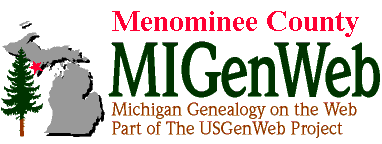Burklund
Township
|
Hokem's Shingle mill was in Lake (then Stephenson) Township but it was a part of what is now called the Burklund Community. It was located about one⁄half mile southwest of the place where the Swedish Lutheran Church now stands. Here the shingles were made and taken to Daggett to be shipped away.
An interesting thing about this mill was that a railroad from the mill to where the logs were picked up was made of thin cedar poles instead of iron rails. These cedar rails or poles were put on top of large logs laid on top of regular railroad ties. These thin cedar rails were fastened to the large logs by wooden pegs. Mules were used to pull the cars on the rails. Just north of Hokem's mill John Humfelt located his lumber mill. Most of the homes in this community have been built from lumber sawed at this mill. He operated this mill alone and sawed about three thousand feet a day. The first power used was horse power. The drive wheel was made entirely of wood, cogs and all. The belting was homemade of heavy mattress material. This Mr. Humfelt donated most of the lumber to the Lutheran Church which still serves this community. He hand-carved the altar and interior woodwork. The first settlers came into the community about the year 1876. They had to go to Stephenson to get to the nearest store. Practically all the pioneer settlers were of Swedish nationality.
The Burklund School grounds were donated to the township by August Haggerman. This was the second school built in Holmes Township, the Pembina school (now Brandt in Faithorn Township) being the first. At that time both Holmes and Faithorn townships were a part of Menominee Township. The first school in this community was built in 1881-2, but about 1901 a larger school was built on the same grounds and the old building was used for a township hall and is still in use today. (NOTE: School was held in this community for three months in the year 1880-81, although there was no school building. It was maintained by contributions. The district was No. 7 of Menominee Township then; W.J. Argabrite was the first director. Seventeen children of school age lived in the district, eleven of whom attended school according to the report made for 1881. The salary paid teachers was $60 for the three months. The following year with a building that cost $600, school was held for six months. Thirty-one children were listed on the census, and of these 18 attended school. The 1888 census listed 62, showing the rapid growth of the community, and 38 of these were in school.)
Most of the pioneer farmers were homesteaders. They took out tanbark to make their living. This was the bark of the hemlock used for tanning leather. In 1919 the farmers started a cheese factory. This factory is owned and operated by the farmers of the community.
|
